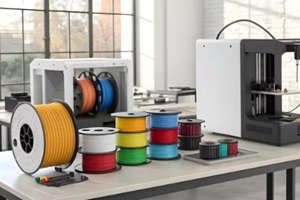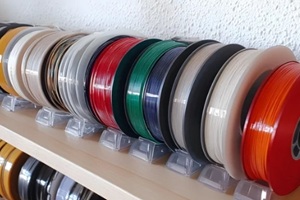December 30, 2024

With a world that’s becoming increasingly eco-conscious, where sustainability and innovation are more important than ever, companies are constantly finding ways to reduce their reliance on virgin plastics to manufacture their goods. A Swedish polymer company has been making waves in sustainability recently by creating innovative 3D printing filament spools made from plastic recycling.
These new spools, designed to work with winding machines, are crafted entirely from 100% recycled materials.
There’s a new standard being set in modern sustainability thanks to the cutting-edge 3D printing filament spools made entirely from 100% recycled plastic.
Designed to be compatible with winding machines, these filament spools meet the technical demands of modern 3D printing while representing a significant step forward in environmentally conscious manufacturing. The entire production process showcases a clear commitment to reducing environmental impact.
The conversion of plastic waste into high-quality filament spools illustrates how sustainable practices can be seamlessly integrated into industrial manufacturing, offering a viable solution for lowering the plastics industry’s broader carbon footprint.
These new filament spools support more than recycling; they reinforce maintaining high technical standards. In a state-of-the-art in-house lab, recycled materials are compounded to guarantee the spools’ technical stability and reliability.
The painstaking process guarantees that the spools perform just as well, if not better, than those made from new materials. Beyond the technical aspects alone, the environmental benefits they provide are quite substantial.
Products made from these recycled materials have a lower climate impact compared to traditional spools, which is proving revolutionary for companies looking to meet sustainability goals without compromising on quality or performance.
The focus on sustainable manufacturing shines through in the use of advanced facilities and inventive technology to recycle materials for use in the production of new plastics. In this way, state-of-the-art equipment blends and refines recycled plastics so that each batch of polymer produced meets the high technical standards possible.
These processes are carefully controlled to repeatedly produce reliable, high-quality products for manufacturers.
With rigorous testing and quality checks in place, the industry delivers recycled products that perform consistently—all while meeting the demand for both sustainability and excellence across a variety of different operations and applications.

Transforming recycled plastic into filament spools involves a detailed and precise process that prioritizes sustainability. It begins with collecting and sorting plastic waste, which is then thoroughly cleaned and shredded into small, uniform pieces.
These pieces are then fed into the compounding process, where they’re melted and blended to create a stable, consistent material. Once the plastic is compounded, it’s extruded into filament spools, cooled, and then subjected to rigorous quality checks to guarantee their consistency and general durability.
Throughout this process, various technical challenges are addressed, such as maintaining uniformity and stability in the final product. Innovative solutions are implemented to overcome these challenges, resulting in filament spools that meet the high standards of the plastics industry.
Several important changes in design and functionality have come with the development of these new recycled 3D printing filament spools.
These include improved spool geometry for better winding and unwinding, which provides smooth and uninterrupted 3D printing. On top of this, these spools also feature enhanced rigidity and strength to help reduce the risk of any warping or breaking.
Join our PLASTICS Pulse newsletter today to receive updates on within the plastic industry while staying informed & connected.
The shift to recycled plastic filament spools brings several notable advantages over traditional options. First and foremost, these spools are crafted from 100% recycled materials, contributing significantly to reducing plastic waste.
With performance that’s equal to or even surpassing new materials, they also promote efforts toward meeting sustainability goals. When companies opt for recycled filament spools over those produced using virgin plastics, companies can align their practices with eco-friendly standards while actively demonstrating a clear commitment to environmental responsibility.
Among the most compelling benefits of recycled plastic filament spools is the lower carbon footprint they provide. These recycled spools have up to a 78% lower CO2 footprint than spools made from new materials.
The significant reduction in emissions marks a major advancement in lessening the environmental impact of manufacturing processes used in plastic production. In the broader context of global sustainability efforts, this reduction supports the transition toward greener practices and helps meet essential climate targets.

The environmental advantages of recycled filament spools persist well beyond their first application. These products are designed to be used, recycled, and reused multiple times, aligning with the basic principles of a circular economy.
The lifecycle of a recycled filament spool begins with its production from repurposed plastic, continues through its use in 3D printing, and ultimately supports recycling at the end of its life.
These spools illustrate how reducing CO2 footprints and promoting a circular economy can help the plastics industry drive positive change for the planet, creating a better future for all of us. PLASTICS, the Plastics Industry Association, offers invaluable resources and support for those interested in advancing their knowledge and practices in the plastic recycling.
Visit our website and review our many resources for more information about the industry. Become a member today to stay at the forefront of sustainability and innovation impacting the plastics sector.
PLASTICS and the Future Leaders in Plastics (FLiP) Committee are devoted to supporting and encouraging the next generation of plastics leaders who will play a crucial role in the innovation, technology and future of the plastics industry. FLiP’s mission is to provide young professionals under the age of 40 the exposure, education and resources they need to build lifelong careers in plastics. Want to join? Want to get your employees involved? Email: [email protected]